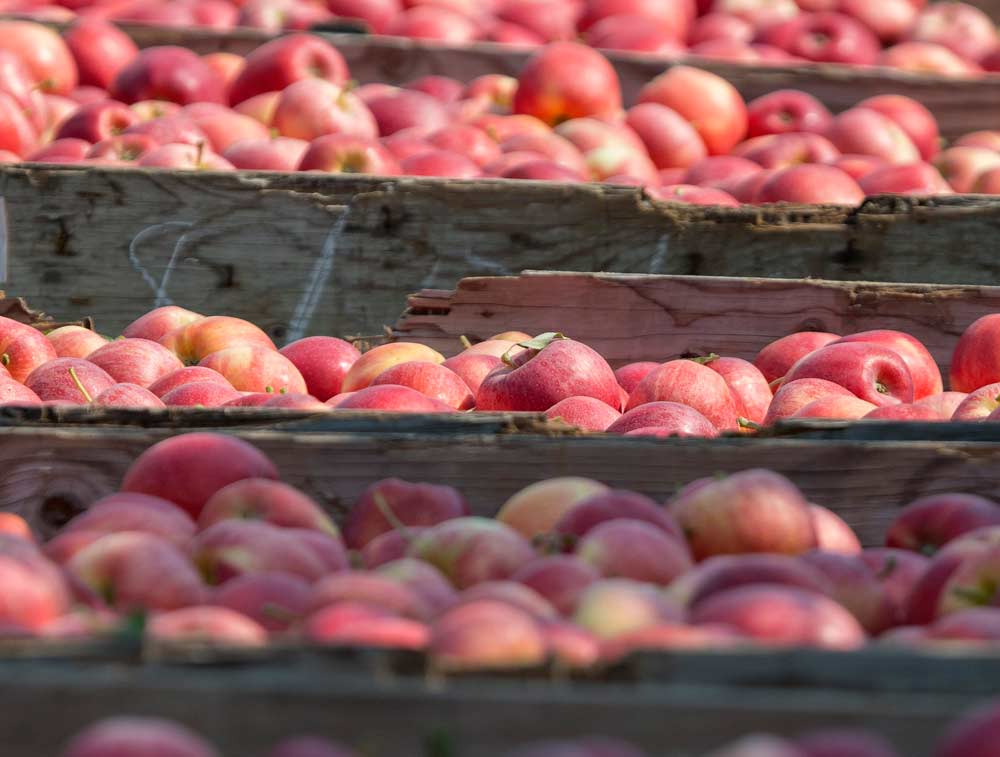
Gala apples harvested north of Wapato, Washington, in 2015. While Galas and Red Delicious together make up 30 percent of the Washington apple crop, they represent more than 65 percent of exported varieties over the last five years. (TJ Mullinax/Good Fruit Grower file photo)
As part of its new, five-year strategic plan, the Washington Apple Commission has proposed prioritizing its marketing efforts and spending for the next two to three years on Red Delicious and Gala apples in five key international markets: Mexico, India, China and Hong Kong, Vietnam and Indonesia.
The proposal is in line with the organization’s last strategic plan, completed in 2011, which placed export focus on China, India and Southeast Asia, particularly Vietnam and Indonesia, while maintaining strong exports to Canada and Mexico.
“We clearly identified the markets where we saw value-plus,” WAC President Todd Fryhover told commission members in a March meeting.
At the same time, Fryhover proposed rolling back marketing spending to 2012 levels in several foreign markets where retail sales have been deemed less advantageous to growers — Central America, Thailand, Malaysia and Singapore, Taiwan, the Middle East and Colombia and Peru — for a savings of about $700,000 in the 2016-17 crop year.
“In principle, for the next two to three years, we see that as no surprise that the focus will be Reds and Galas,” he said. “The more we can move to foreign markets, especially dispersed to some of our value-added markets, the better off the growers are going to be.”
Reds and Galas represent 30 percent of the Washington crop, but more than 65 percent of exports over the last five years. Fryhover noted that Washington maintains a growing advantage on Red Delicious, but that Galas are being grown worldwide, increasing the competitive pressure in foreign markets.
A complex world view
In 2011, when the last strategic plan was compiled, the international market was far less complicated.
In 2014, Russian President Vladimir Putin enacted an embargo on the importation of fruits and vegetables, among other products, from several countries, including the U.S., Canada and the European Union. That move has changed the landscape for exports tremendously, both in Europe and the Middle East.
Fryhover suggested commissioners consider whether there is continued value in expending resources in Russia, given the closure. “If that market does open up, it will be to Poland, some others,” he said, adding, “We’ll get indirect benefits of opening of other markets with that movement.”
He also said commission staff would take a hard look at marketing activities in Western Europe given the impact of the embargo there.
In addition, China’s production continues to grow — 24 percent from 2014 to 2015 — though so does its population of middle-income people or higher. Online retail sales targeting those consumers are substantially changing the marketplace there.
Domestically, an increasing number of new varieties are competing for acreage and space on packing lines, and increasing vertical integration of the industry means many companies will push varieties that bring in higher returns.
The Washington Apple Commission also surveyed Washington growers last year on production and export volumes to examine sales trends; that data is still being compiled. The Washington State Tree Fruit Association also has contracted the U.S. Department of Agriculture’s National Agricultural Statistics Service to complete a tree and acreage survey this year.
The commission’s proposed 2016-17 budget totals $7.56 million, including $5.15 million in USDA Market Access Program funds. The remainder comes from the 3.5 cent per box assessment growers pay to the commission, which pays for foreign export efforts (2 cents), domestic activities by USApple (0.8 cents), the Northwest Horticultural Council (0.4 cents) and administrative costs of the commission (0.3 cents).
Commissioners are scheduled to vote on a proposed budget at their May 25 board meeting, after which staff members will meet with marketing representatives in foreign markets to establish marketing plans before the next crop year. •
– by Shannon Dininny






Leave A Comment